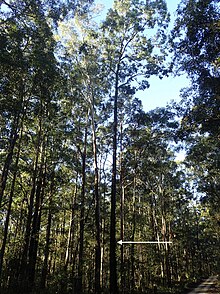
Eucalyptus crebra, commonly known as the narrow-leaved ironbark, narrow-leaved red ironbark or simply ironbark, and as muggago in the indigenous Dharawal language, is a species of small to medium-sized tree endemic to eastern Australia. It has hard, rough "ironbark" from its trunk to small branches, linear to lance-shaped adult leaves, flower buds in groups of seven, nine or eleven, white flowers and cup-shaped, barrel-shaped or hemispherical fruit. A variable species, it grows in woodland and forest from the Cape York Peninsula to near Sydney. It is an important source of nectar in the honey industry and its hard, strong timber is used in construction.

Eucalyptus fibrosa, commonly known as the red ironbark, broad-leaved red ironbark or broad-leaved red ironbark, is a species of medium-sized to tall tree endemic to eastern Australia. It has grey to black ironbark, lance-shaped to egg-shaped adult leaves, flower buds in groups of between seven and eleven, white flowers and conical fruit.

Eucalyptus staigeriana, commonly known as the lemon-scented ironbark, is a species of small ironbark tree that is endemic to the Cape York Peninsula. It has rough ironbark on the trunk and branches, lance-shaped to egg-shaped leaves that smell of lemons when crushed, flower buds in groups of seven, white flowers and oval to spindle-shaped fruit.

Eucalyptus melliodora, commonly known as yellow box, honey box or yellow ironbark, is a species of medium-sized to occasionally tall tree that is endemic to south-eastern, continental Australia. It has rough, flaky or fibrous bark on part or all of the trunk, smooth greyish to yellowish bark above. The adult leaves are lance-shaped to egg-shaped, the flower buds are arranged in groups of seven and the fruit is more or less hemispherical.
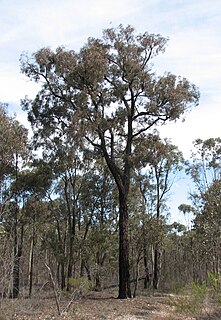
Eucalyptus tricarpa, commonly known as red ironbark or mugga ironbark, is a species of tree that is endemic to south-eastern Australia. It has thick, rough ironbark on the trunk and branches, lance-shaped adult leaves, flower buds usually in groups of three, white flowers and cylindrical or spherical fruit.
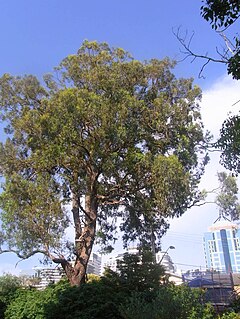
Eucalyptus paniculata, commonly known as grey ironbark, is a species of tree that is endemic to New South Wales. It has dark-coloured, deeply furrowed ironbark on the trunk and branches, lance-shaped to curved adult leaves, flower buds in groups of seven on a branched peduncle, white flowers and conical, hemispherical or cup-shaped fruit.

Eucalyptus quadrangulata, commonly known as the white-topped box or coast white box, is a species of small to medium-sized tree that is endemic to eastern Australia. It has rough, fibrous or flaky bark on the trunk and branches, lance-shaped to curved adult leaves, flower buds in groups of seven, white flowers and conical fruit.
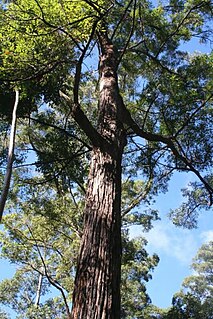
Eucalyptus siderophloia, commonly known as the northern grey ironbark, is a medium-sized to tall ironbark tree that is endemic to south eastern Australia. It has hard, dark, furrowed bark, lance-shaped to curved adult leaves, flower buds in groups of seven, white flowers and cup-shaped or conical fruit.
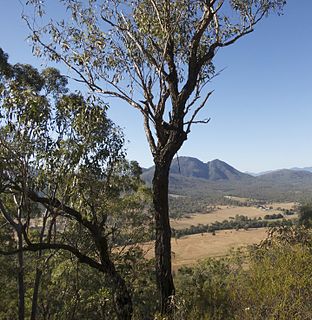
Eucalyptus dura is a species of small to medium sized tree that is endemic to south-eastern Queensland. It has rough, dark grey to black "ironbark", lance-shaped adult leaves, flower buds in groups of seven, white flowers and conical fruit.

Eucalyptus pyrocarpa, commonly known as the large-fruited blackbutt, is a species of medium-sized tree that is endemic to New South Wales. It has rough bark on the trunk and larger branches, smooth grey to white bark above, lance-shaped to curved adult leaves, flower buds in groups of between seven and eleven, white flowers and cup-shaped, barrel-shaped or pear-shaped fruit.
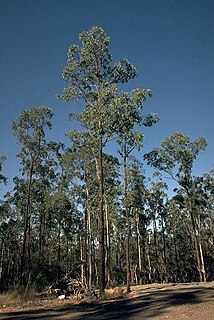
Eucalyptus tetrapleura, commonly known as the square-fruited ironbark, is a species of small to medium-sized tree that is endemic to northern New South Wales. It has thick, dark ironbark on the trunk and branches, lance-shaped to curved adult leaves, flower buds in groups of seven, white flowers and conical fruit that is square in cross-section.
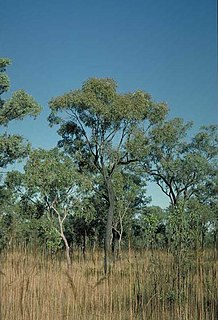
Eucalyptus jensenii, commonly known as Wandi ironbark, is a species of tree that is endemic to northern Australia. It has hard, coarse black "ironbark", egg-shaped to lance-shaped adult leaves, flower buds in groups of seven, creamy white flowers and barrel-shaped to conical fruit.
Eucalyptus cullenii, commonly known as Cullen's ironbark, is a species of small to medium-sized tree that is endemic to Queensland. It has thick, rough, deeply furrowed "ironbark", lance-shaped adult leaves, green to yellow flower buds in groups of seven, white flowers and hemispherical fruit.

Eucalyptus decorticans, commonly known as the gum-top ironbark, is a species of tree that is endemic to Queensland. It has rough, dark grey or black "ironbark" on the trunk and larger branches, smooth white bark on the thinner branches, lance-shaped to curved adult leaves, flower buds in groups of seven, white flowers and conical, cup-shaped or barrel-shaped fruit.
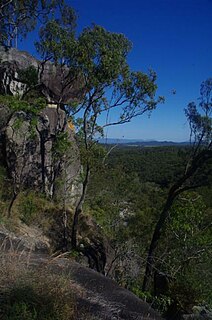
Eucalyptus granitica, commonly known as the granite ironbark, is a species of tree that is endemic to Queensland. It has dark grey or black "ironbark" on the trunk and branches, glossy green, lance-shaped to curved adult leaves, flower buds in groups of seven, white flowers and cup-shaped to barrel-shaped fruit.
Eucalyptus melanoleuca, commonly known as yarraman ironbark or nanango ironbark, is a species of tree that is endemic to south-east Queensland. It has rough ironbark on the trunk and larger branches, smooth bark above, lance-shaped adult leaves, flower buds in groups of seven, white flowers and barrel-shaped, to cup-shaped or conical fruit.
Eucalyptus suffulgens is a small to medium-sized tree that is endemic to Queensland. It has hard ironbark on the trunk and larger branches, smooth bark above, lance-shaped adult leaves, flower buds in groups of seven on the ends of branchlets, white flowers and barrel-shaped fruit.
Eucalyptus taurina, commonly known as the Helidon ironbark, is a species of medium-sized to tall ironbark that is endemic to Queensland. It has rough ironbark on the trunk and sometimes the larger branches, smooth bark above, lance-shaped adult leaves, flower buds in groups of seven, white flowers and conical to hemispherical fruit.
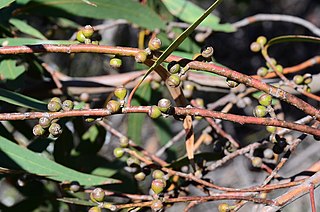
Eucalyptus sabulosa, commonly known as Wimmera scentbark, is a species of small, spreading tree that is endemic to Victoria, Australia. It has fibrous or scaly bark on the trunk and branches, lance-shaped to curved adult leaves, flower buds in groups of seven, white flowers and oval to almost spherical fruit.
Eucalyptus splendens, commonly known as apple jack, is a species of small, spreading tree that is endemic to a small area of Victoria, Australia. It has fibrous or corky bark on the trunk and thicker branches, lance-shaped to curved adult leaves, flower buds in groups of seven, white flowers and hemispherical to cup-shaped fruit.
